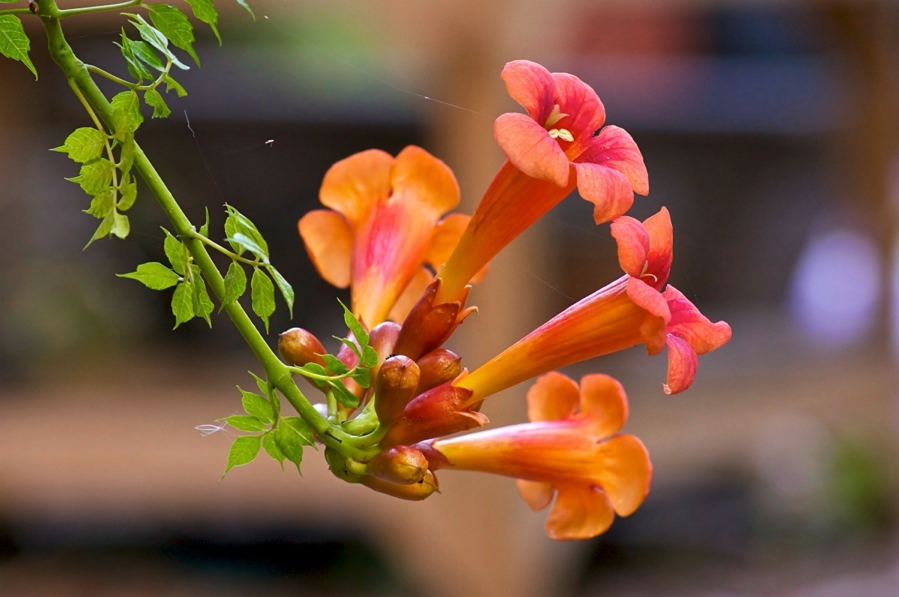Campsis radicans: Trumpet Vine
 Latin name: Campsis radicans
Latin name: Campsis radicans
Common name: Trumpet Vine19
Flowers: Conspicuous, 3-4” trumpet shaped red-orange flowers, bloom June-September10,12
Fruit: 3-6” seed pods, split open and release two-winged seeds when ripe10,12
Height & Width: 30+ feet5,19
Type: Perennial, woody vine, groundcover5,10
Habit: Clinging, climbing, creeping; grow on sturdy support5,10
Wetland indicator category**: FAC17
Texture: Medium10
Growth rate: Fast, aggressive5,10,12,19
Light: Full sun, part sun5,10,12,19
Moisture: Drought tolerant; prefers well-drained moist soil5,19
Soil*: Moist, well-drained soil; pH range (6.8-7.2), tolerates acidic and alkaline soil5,19
Zones: 4-85
Origin: Native in Eastern United States as far north as Ohio and as far south as Texas, and some areas of Eastern Canada10,16
Ecosystem benefits: Attracts pollinators such as butterflies, hummingbirds, and bees, nectar source, naturally good erosion control5,10,12,19
Features: This is a desirable plant because of its ability to attract a wide variety of pollinators such as butterflies, hummingbirds, and bees. It has 3-4” trumpet shaped flowers that grow in clusters. It has red-orange flowers, as well as a yellow cultivar10. Trumpet vine is easy to establish and can be used to decorate landscapes beautifully if managed properly.
Siting: Strategic siting is necessary to successfully maintain Trumpet Vine. Trumpet Vine uses aerial rootlets to spread which can cause damage to wood, brick, and stone10,12. It is recommended that you site this plant on a structure such as a vinyl decorative archway or somewhere that pruning will not be a problem, as you will have to control the plants aggressive growth12. This plant is drought tolerant and blooms best in full sunlight10.
Care: For transplanting, plant crown at soil level18. At planting, water the roots and surrounding area slowly and deeply. Keep soil moist until plant is established, then apply enough water to thoroughly moisten the root zone when the soil is dry or during drought. Modify water recommendations to reflect site drainage and rainfall. Apply 3” of mulch over the planted area. Do not allow mulch to touch the plant stems18. You may also propagate by cuttings, seeds, or semi-hardwood cuttings10.
Pests: Deer resistant, no serious pest issues5,10,12,19.
Cautions*: The sap of this plant can cause skin irritation on contact10,12.
This plant does not appear on the following invasive plant lists on (02/25/2019):
- USDA SC Invasive Plant Species Web site at http://www.invasivespeciesinfo.gov/plants/main.shtml
- SC Exotic Plant Pest Council Web site at http://www.se-eppc.org/southcarolina/
Author: Kieran McKinney
Image source: https://www.thriftyfun.com/Growing-Perennial-Vines.html
Sources:
- Armitage, A. (2001). Armitage’s manual of annuals, biennials, and half-hardy perennials. Portland, OR: Timber Press.
- Armitage, A. (2006). Armitage’s native plants for North American gardens. Portland, Oregon: Timber Press.
- Armitage, A. (2008). Herbaceous perennial plants: A treatise on their identification, culture, and garden attributes. Athens, GA: University of Georgia.
- Clemson Cooperative Extension Home and Garden Information Center.(2011). Flowers fact sheets. Retrieved from https://hgic.clemson.edu/category/flowers/
- Clemson Cooperative Extension Home and Garden Information Center.(2011). Groundcovers & vines fact sheets. Retrieved from https://hgic.clemson.edu/category/groundcovers/
- Clemson Cooperative Extension Home and Garden Information Center.(2011). Trees. Retrieved from https://hgic.clemson.edu/category/trees/
- Clemson Cooperative Extension Home and Garden Information Center.(2011). Shrubs. Retrieved from https://hgic.clemson.edu/category/shrubs/
- Dirr, M. A. (2009). Manual of woody landscape plants. Champaign, IL: Stipes Publishing.
- Gilman, E. F. (1997). Trees for urban and suburban landscapes. Albany, NY: Delmar Publishers.
- Lady Bird Johnson Wildflower Center University of Texas at Austin. (2012). Native plant information network. Retrieved from http://www.wildflower.org/explore/
- McMillan, P., Plant taxonomist Clemson University, personal communication.
- Missouri Botanical Garden Kemper Center for Home Gardening. Plant finder. Retrieved from http://www.mobot.org/gardeninghelp/plantfinder/Alpha.asp
- North Carolina State University (2005). Plant fact sheets. Retrieved from http://www.ces.ncsu.edu/depts/hort/consumer/factsheets/index.html
- Strother, E. V., Ham, D. L., Gilland, L. (2003) Urban tree species guide: Choosing the right tree for the right place. Columbia, SC: South Carolina Forestry Commission.
- University of Florida, IFAS Extension. (2011). Southern trees fact sheet. Retrieved from http://edis.ifas.ufl.edu/department_envhort-trees
- USDA. Plant profile. (n/d).Retrieved from http://plants.usda.gov/java/
- USDA. Plant wetland indicator status. (n/d). Retrieved from http://plants.usda.gov/wetland.html
- Vincent, E., Environmental horticulturist Clemson University, personal communication.
- Clemson Extension. Carolina Yards Plant Database. Retrieved from https://www.clemson.edu/extension/carolinayards/plant-database/index.html
- Add additional sources starting here
*Soil pH is determined using a professional soil test. Contact your Clemson University County Extension service for assistance www.clemson.edu/extension/. Click on “local offices”.
**2012 Plant Wetland Indicator categories (quantitative derived) http://plants.usda.gov/wetinfo.html
| Indicator Code | Indicator Status | Comment |
|---|---|---|
| OBL | Obligate Wetland | Almost always is a hydrophyte, rarely in uplands |
| FACW | Facultative Wetland | Usually is a hydrophyte but occasionally found in uplands |
| FAC | Facultative | Commonly occurs as either a hydrophyte or non-hydrophyte |
| FACU | Facultative Upland | Occasionally is a hydrophyte but usually occurs in uplands |
| UPL | Obligate Upland | Rarely is a hydrophyte, almost always in uplands |
